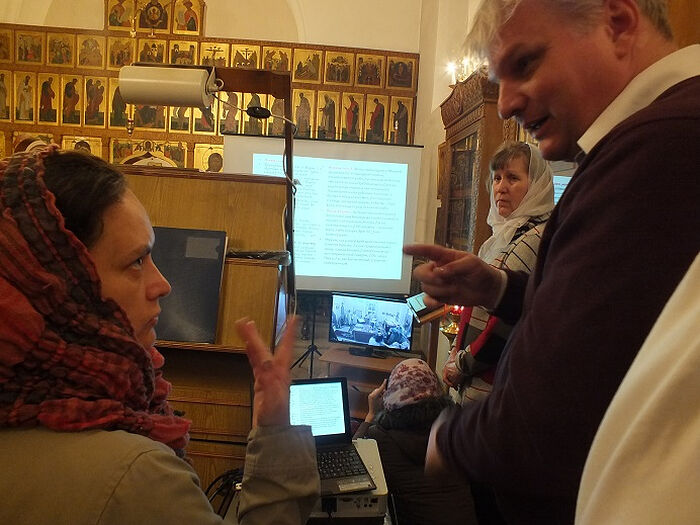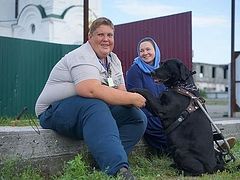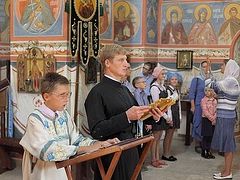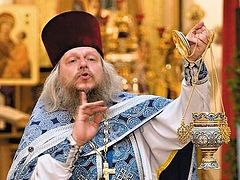In the beginning was the Word (Jn. 1:1)... We are used to perceive the church services primarily through the text. But how do those who are deaf pray? For an answer to this question I travelled to Klin [a small historic town fifty-three miles north-west of Moscow.—Trans.], to the Church of St. Tikhon, Patriarch of Moscow and All Russia, where for over fifteen years services have been celebrated with simultaneous Russian Sign Language interpretation. We talked with its priest, Archpriest Anatoly Frolov.
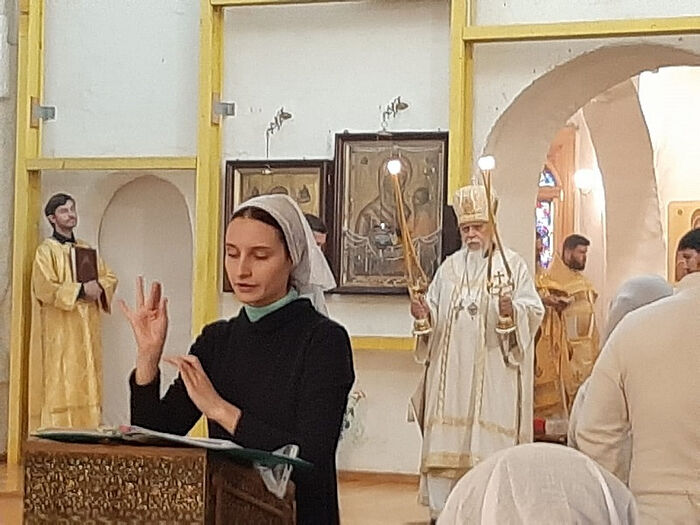 Hierarchical Liturgy at the church of the former Simonov Monastery in Moscow. World Day of the Deaf, celebrated on last Sunday of September
Hierarchical Liturgy at the church of the former Simonov Monastery in Moscow. World Day of the Deaf, celebrated on last Sunday of September
—Hard of hearing and deaf people are called differently gifted. Is it true that the Lord grants something in return to disabled people—those who are deprived of some of the opportunities that all of us are used to?
—People with hearing impairments have their own language, perception of the world, culture, and mentality. Almost all of them read lips and facial expressions. Deaf people are very perceptive. By the expression on your face they will immediately notice if you are lying and speaking insincerely. They are likely to tell you about it at once. Thanks to this, it is pleasant to communicate with them—you are confident of mutual sincerity. Children with hearing impaired and deaf parents develop faster and better intellectually. As you know, fine motor skills facilitate brain development, and such children from infancy get used to following the gestures of their parents and repeating them (and their speech is normal). There are very talented people among the deaf. For example, Dmitry Balashov, thanks to whom this work began at our church. He is well educated and has perfect literacy; he doesn’t make a single mistake, and all his commas are in place. Obviously, he visually discerns and remembers intonations. His language is beautiful and figurative, and he is a wonderful storyteller!
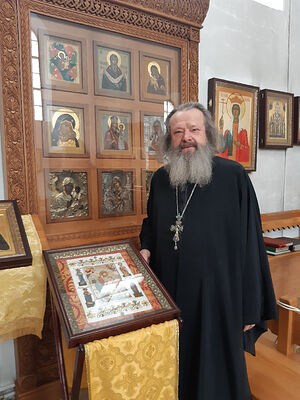 Archpriest Anatoly Frolov —I thought deaf people couldn’t speak...
Archpriest Anatoly Frolov —I thought deaf people couldn’t speak...
—It's a misconception. Almost all of them speak, many indistinctly, and some quite clearly. As for Dmitry, he lost his hearing when he was about one year old. Fortunately, his parents did all in their power to develop the boy; they worked with him diligently, and he became a highly educated young man with a great interest in life, the world, and people. He graduated from the Sholokhov Moscow State University for Humanities and St. Tikhon’s Orthodox Institute (now university) successfully. Then, in the 1990s, there was a group of hearing impaired and deaf people attached to the Novodevichy Convent of the Smolensk Icon of the Mother of God in Moscow. Dmitry began to attend their services. In 2005, representatives of the Society of the Deaf in Klin contacted me with a request to help a group of deaf people be catechized. They began to meet at our church for services, parish tea parties, and make joint trips and pilgrimages. Where have they not been! They’ve been to the Altai Mountains twice, visited Baikal and Kamchatka, flown to England and Israel! Before the pandemic, they visited monasteries and exhibitions. I traveled with them. And, of course, an important part of the work is catechization. People study the Orthodox faith, Holy Scripture and Tradition. Dmitry led this movement and became our catechist. A friend of our parish, Protodeacon Pavel Troshinkin, interprets services into sign language. What is especially valuable is that his interpretations are not formal; but, as Blessed Jerome of Stridon said, “Sense for sense and not word for word.” Dmitry turned to His Holiness the Patriarch, writing to him about how he saw pastoring hearing impaired people in the Church and publishing his Ph.D thesis and article, “The Socialization of Deaf People in the Russian Orthodox Church”. This was an important step in the development of work with hearing impaired and deaf people at the Church level.
—Is this work being carried on?
—Yes, now the Center for Work with the Deaf, Deafblind, and Hard of Hearing of the Synodal Department for Church Charity and Social Ministry is in charge of this. It is headed by Bishop Panteleimon (Shatov). Of course, we are not the only church to help such people. There is a boarding school for deafblind children in Sergiyev Posad, where they are pastored by monks from the Holy Trinity-St. Sergius Lavra. In Moscow, the Church of the Tikhvin Icon of the former Simonov Monastery and the Church of All Saints of the Russian Land in the Novokosino district work with deaf people as well, and there are about fifty such churches throughout Russia.
—Are separate services for the hearing impaired held at St. Tikhon’s Church?
—No. Our other parishioners are also present at these services. As a rule, hearing impaired people meet on Saturdays as it is convenient for them, but, of course, they also come on the major Church feasts. On the last Sunday of September, World Day of the Deaf, large groups come. We put up a screen on the right near the solea so that it will not interfere with seeing the service, and display the text of the service on it. When we put up this screen for the first time on Pascha, our regular parishioners said: “Father, how great! Now it’s clear what they were singing!” When there are hearing impaired people in the church, I say all the prayers aloud so they can read our lips. I began to serve with the royal doors open for them. Then His Holiness issued the decree for churches to serve with the royal doors open if there are any deaf members in the communities.
—How do they confess?
—They give me paper notes with the lists of their sins, and I answer them in writing. A deaf person cannot confess with gestures, otherwise the others will see and “read” it.
—Are hearing-impaired and deaf people involved in parish life?
—Certainly! We have a united parish, and hard of hearing people are involved in parish life along with the other faithful. We celebrate the feasts and meet for tea parties. Actually we have as many as six patronal feasts: St. Tikhon is commemorated four times a year, plus the feasts of the New Martyrs and the Holy Hierarchs of Moscow. For the hearing impaired faithful we set up a separate table so they can talk and see each other. But, of course, they also communicate with other parishioners. They are always happy to come to children’s festivals and Christmas shows. Many of them got married and then had their children baptized here.
—Your church has an unusual icon of beautiful gold embroidery, depicting the healing of a deaf and mute man by the Savior. How did it appear?
—It is a unique icon, and I don’t know if there are similar ones anywhere else. It was embroidered by Tatiana Serkova, head of the Yakhont gold embroidery workshop, our hard of hearing parishioner. By the way, if you carefully read in the Gospel about the healing of a deaf and mute man by the Savior, you will see that the Lord applies the basic principles of working with deaf people: touch and a visual image, which compensates for the lack of hearing: And they bring unto Him one that was deaf, and had an impediment in his speech; and they beseech Him to put His hand upon him. And He took him aside from the multitude, and put His fingers into his ears, and He spit, and touched his tongue; And looking up to heaven, He sighed, and saith unto him, Ephphatha, that is, Be opened. And straightway his ears were opened, and the string of his tongue was loosed, and he spake plain (Mk. 7:32-35). Through touch Christ made it clear to the man that he was about to be healed. By looking up to Heaven He visibly showed that He was praying to the Heavenly Father and calling on him to do the same.
—Therefore, it is very important for hearing impaired and deaf people to make up for the lack of sound with other sources of information and emotions, right?
—Yes, it is. Such people “hear with their eyes.” That is why it is important for us to cover the church with frescoes (so far the walls have been white). This is what the parishioners really want, especially the deaf ones. Frescoes will serve as an illustration of worship for them and add color to their perception. By the way, the fundraising for the mural project is carried out by the Archangel Michael Fund. If anyone wants to help, they can do so here: https://clck.ru/aqyQL

